Share this
6 Surprising Problems Social Listening Can Solve for You
by Infegy Research Team on September 9, 2019
Not all social analytics tools are created equal.
There are a seemingly endless number of solutions; the lists of bells and whistles goes on and on.
But what many social data platforms often fail to do is translate to other key business efforts for your overall strategy.
Social listening tools, however, are different. They’re capable of providing the often-missed context for solving some of your more perplexing marketing and advertising problems. And some of these solutions may surprise you.
If you’re exploring the potential need to add a social listening platform to your arsenal of analytics tools, consider some of the potential uses your team might need.
Here are just some of those problems you face that social listening can help with:
- How can you track your audiences through the customer journey?
- How can you perform better Adwords research and create better search ad campaigns?
- How did your offline campaign perform?
- How did people review your products/services online?
- How can you plan a successful hashtag campaign and gauge the success of past campaigns?
- How can you monitor consumer expressions like brand trust and purchase intent?
These 6 common problems for your marketing, advertising, social or research teams have solutions, thanks to social listening.
Let’s take a look at how it can be used to solve those problems. Here are the questions you have and how to solve them with this technology:
1. Track and analyze audiences through the Customer Journey
The Problem: It can be difficult to know how people in your target make their way through the customer journey. You need data to understand it better.
Social Listening Solution: Specific metrics available with social listening tools like Infegy Atlas can help you get a holistic understanding of who your potential customers are and what they’re saying about you, their needs and pain points, and their potential buying behaviors. You can analyze audiences all the way through the journey, from the awareness, to consideration, to purchase, to promotion stages.
For each of these stages, social listening can help you pinpoint important insights that answer key questions about your consumers, thanks to how they talk online:
Awareness: how many people are talking about the topic/brand/product/service
Consideration: how many people are hinting at making a purchase (what is their background, demographics, interests, etc.)
Purchase: Which audiences made a purchase; what led them to do so
Service: who is commenting on the service provided and how do they feel about it
Retention: what is the satisfaction level of customers
Loyalty: who is expressing they are committed to your brand by specific emotions like love and joy and other indicators
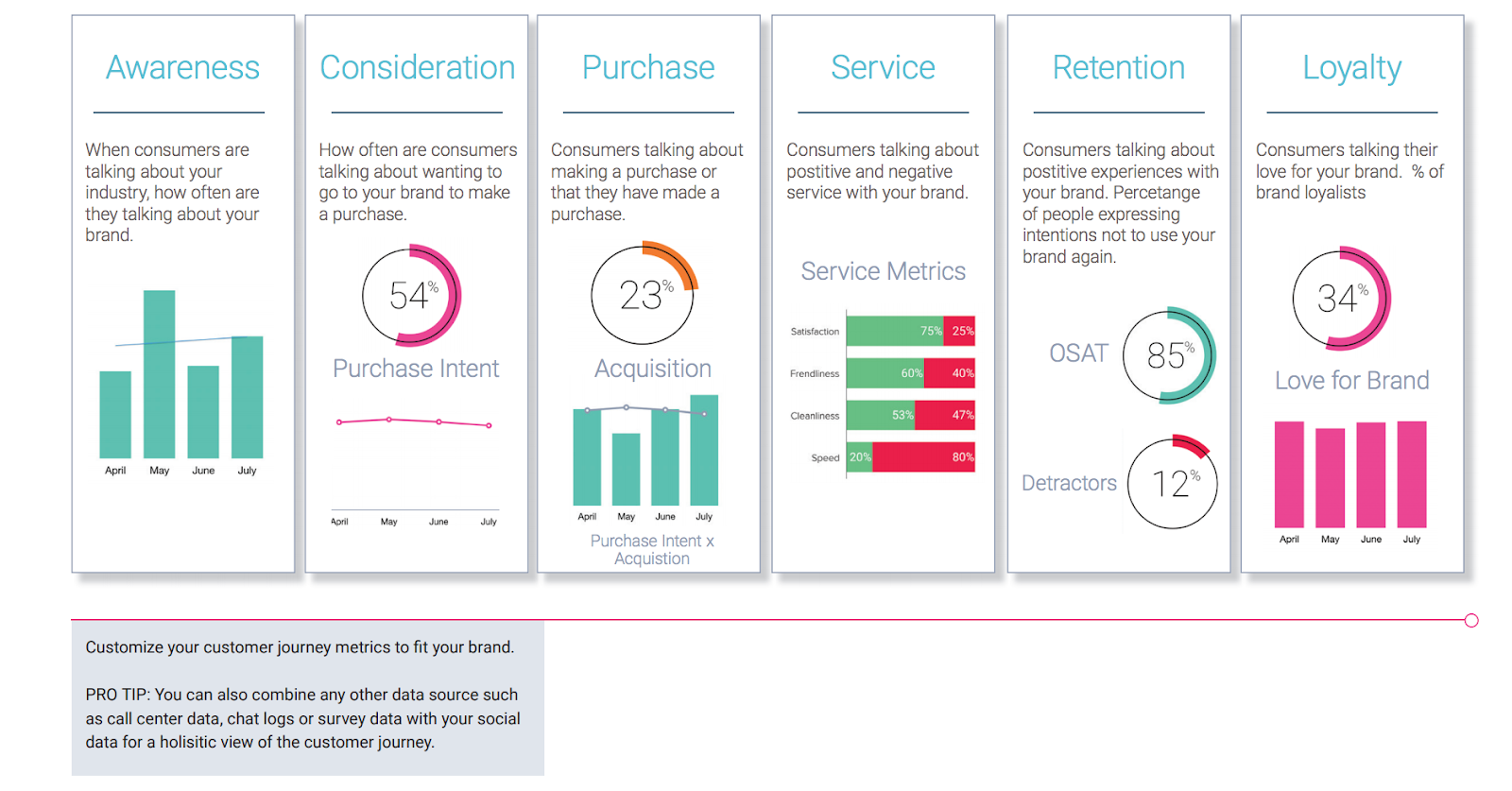
You can see it work in practice by checking out an example in our real-time reporting dashboard, Infegy Canvas here.
You can also see this use case, as well as 9 others, featured in our guide “10 Ways to Use Social Listening for Brand and Business Wins”.
2. Better keyword research and analysis for Adwords campaigns
The Problem: Keyword research doesn’t always turn out good results, even with expensive tools.
Social Listening Solution: If you want to figure out the right keywords to leverage within your search engine ad campaign, you should use the lingo actually used by the people you’re targeting. Additionally, you can use social listening to analyze and understand who online searchers are and what they need.
Tune into the online conversation with social listening to learn the most important keywords, topics, interests and pain points to apply to your Adwords strategy and learn more about the people conducting these searches with the powerful consumer insights.
Infegy client agency Barefoot Proximity uses this strategy to understand the types of people search specific keywords. One industry that has proven especially helpful is in healthcare, where a number of their clients have implemented this strategy to understand patient journeys and pain points. Here’s how it works according to their team:
If people search for their symptoms or healthcare experiences, there’s a good chance the same types of people are also talking about those experiences online.
“If they have a headache, they might search for a specific term around a remedy or medication… Then later they will talk about those treatments online, so we’re looking for analysis on similar audiences that are searching for these various terms.”
You could use social listening to dig further into the various topics your audiences might be searching.
So, if someone is searching for remedies for their headaches, there’s a good chance that those are the ones who are discussing headaches online.
Here, we searched mentions headaches AND medicine within our social listening platform to see the top linguistics word cloud:

You could then click on the terms within the word cloud on the social listening platform and analyze related terms and topics to get a better understanding of which people might be searching these terms:

From here, you can not only learn about the types of Google searchers who you should be considering, but also inform your advertising and Google Adwords planning.
From this data, you might determine that you should target female migraine sufferers with Google Ads.
There’s virtually no limit to how far you can conduct this research to pinpoint various insights that will inform your search engine marketing and advertising strategies using social listening.
3. Track OFFLINE Campaign Performance
The Problem: You can’t measure the performance of your offline campaign like festival activations with online analytics… except you can!
Social Listening Solution: People talk. If your campaign is able to drive consumer conversation, social listening allows you to track and monitor the reaction to that campaign and report on it afterwards to help you with future campaigns.
A Game of Thrones activation at South by Southwest between HBO and The Red Cross garnered a ton of fanfare and attention from online audiences. HBO’s advertising agency, Giant Spoon, led the SXSW campaign.
Our data shows that Giant Spoon achieved its goal of spreading awareness for the non-profit: following a spike in conversations about the event itself, consumers talked more about donating and the Red Cross than at any other point in the prior fifteen weeks.
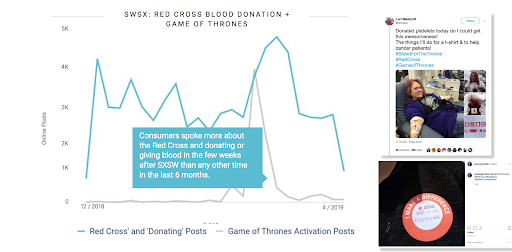
By using social listening analysis of specific event-related hashtags, geography-based online conversations, and audiences who mentioned donating, we were able to reach the chart above, which shows the number of online conversations mentioning donations and Game of Thrones.
Case-in-point: people were talking about this event-- a lot.
This shows that your team can leverage social listening to measure the performance and success of your campaigns and marketing efforts, even if those campaigns happen offline. Don’t underestimate the power of human conversation!
4. Analyze Product/Service Online Reviews
The Problem: Consumers have some flaming hot opinions about your brand and its offerings, but your focus groups and surveys don’t help out all that much. Most online tools rely too heavily on data from channels like Twitter. It would be nice to analyze other areas of consumer feedback.
Social Listening Solution: The ability of social listening to analyze social media conversations is well-documented, but if you have a tool like Infegy Atlas, capable of going beyond social media, you can get analysis like you’ve never had access to before.
Social listening is intuitive and accurate enough to find key actionable business insights hiding within all online conversations, including those that take place outside of social media.
Think about review sites like Amazon. Here are millions of reviews of products, but to get any kind of context to the theme or consensus of those reviews, you’d have to scroll through them all manually.
With the right social listening tools, you can analyze reviews of your products with metrics that exist within the social listening platform itself.
We used metrics such as sentiment analysis, product quality and service to analyze Amazon reviews within our social listening platform to compare wearables like Fitbit’s Charge, Garmin’s Vivosmart and the Microsoft Band.
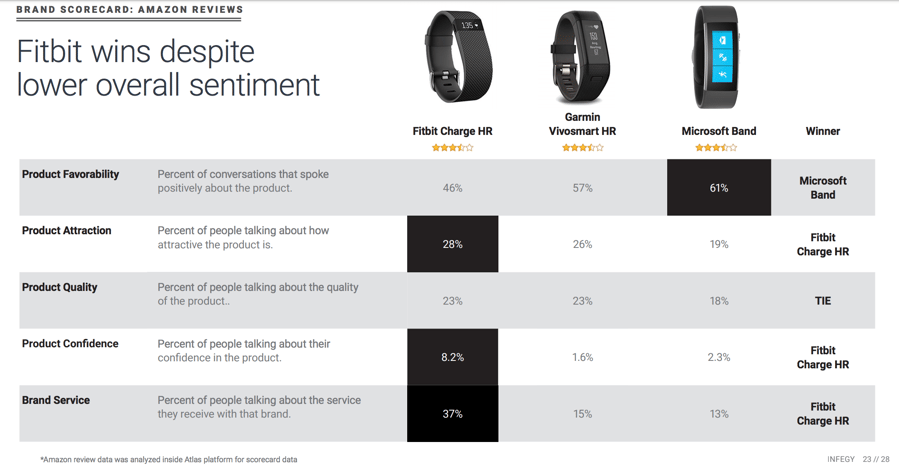
According to our social listening analysis of these Amazon reviews, 8.2% of reviewers expressed confidence in Fitbit, beating the other two devices. However, overall sentiment was lower for Fitbit than both Garmin and Microsoft, despite comparable star ratings.
This shows the importance of analyzing all parts of the online reviews and conversations to understand the context of people’s feelings towards those specific products.
5. Plan A Successful Hashtag Campaign, Gauge Past Success and Learn About Audiences
The Problem: Planning hashtag campaigns are difficult to do without good data to inform them. Analyzing hashtags is challenging, time consuming and often inaccurate. Furthermore, hashtag analysis is often limited to just the hashtag itself.
Social Listening Solution: Social listening allows you to research and understand how people talk online and how they use hashtags to spread and share their voices across the web. On top of that, you can analyze past hashtag campaigns, by your brand or competitors, and find out how audiences used the hashtag and other phrases and see if the right people were reached with the campaign.
Let’s look at the example of the popular hashtag campaign by beauty and hygiene brand Dove called #myhairmycrown.
Notice there was little to no mention of that phrase or hashtag before Dove began the campaign. But lo and behold after they launched the campaign, they saw a huge spike in conversation. More than that, Dove sustained a high level of conversation post-campaign:

Quantity of conversation volume is not the only thing you’re looking to achieve with a hashtag campaign, though. Quality matters too. Were people enthusiastic and excited to tag their posts?
You can also use social listening to examine the level of passion that is expressed when mentioning the hashtag by using the passion score metric. While we see the mentions decrease, we see a steady high level of passion about this campaign from audiences:

You can learn more about audiences and how they talk about you and your brand or products on the social web by going further than just analysis of that one hashtag.
You can take this opportunity to learn more about your audiences by looking at other impactful hashtags that correlate with this campaign: #blackgirlmagic #naturalhair #teamnatural #womenempowerment #myhairmybeauty

Then you can look outside of just hashtags to get insight on other related positive keywords mentioned by those audiences.
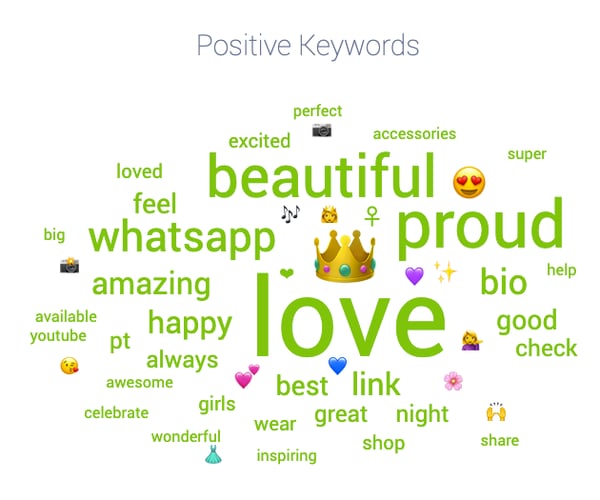
Now, you can start to see how far you can take your analysis with social listening tools.
One angle or area of analysis, such as a branded hashtag, takes you down a rabbit hole of intriguing insights about your campaign and helps you go further than just the campaign to learn more about your audiences and potential customers.
6. Track Audience Feelings and Actions, Such as Expressing Trust in Your Brand or Purchase Intent
The Problem: Do people trust your company? Are they looking to buy? Are they happy with your service? You’re missing insights on specific themes such as: consumer trust and how do people express an intent to purchase. If only you had real metrics on this..
Social Listening Solution: The custom theme metrics within social listening tools uncover hidden insights about consumers and how they express specific themes and emotions in their online conversations. You can analyze and filter searches of audience conversations by these specific themes and they are built-in as metrics right within the dashboard. Using these features, you can research audiences to see if they trust your brand or if they mention something relevant to becoming a buyer, if they are happy with your service.
Additionally, you can find and build your own themes and categories using advanced research within your social listening query. So, if you want to know which beauty brand is winning the “organic beauty” category, you can create a customized category and conduct the analysis and compare other brands in the industry.
This type of insight could be crucial in not just analyzing audiences and comparing your brand or business to others but also to recognize opportunities.
In our social insights report for the beauty industry, we looked at the changing landscape of beauty and cosmetic products and the increased demand for natural and organic products.
Featured in the report is this brand scorecard with a competitive analysis of various beauty brands in the natural beauty category.
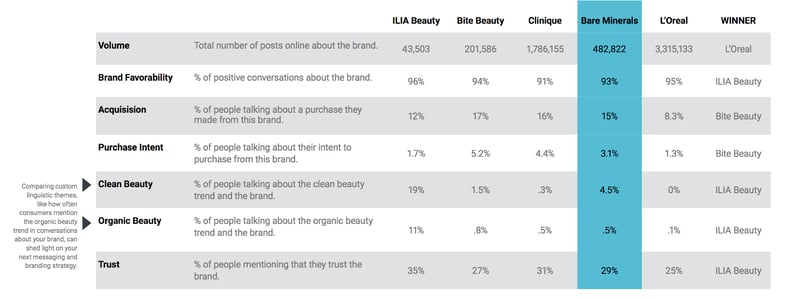
The first thing you see is that L’Oreal, the biggest name brand on the list, leads in post volume. Not surprising. Next, you see that ILIA Beauty appears the most in the “winner” column, leading other brands in brand favorability, consumer trust and the categories of “clean beauty” and “organic beauty. In the purchase intent metric, you find that Bite Beauty consumers express the most intent to buy.
Another key insight: Bare Minerals, which pioneered mineral and natural beauty products, misses out on the organic beauty conversation according social listening analysis.
This could present an opportunity for the brand to attract more audience attention.
Comparing custom linguistic themes, like how often consumers mention the organic beauty trend in conversations about your brand, can shed light on your next messaging and branding strategy and gives you insight into how people discuss their wants and needs with regard to specific brands and products.
Conclusion
There you have it: 6 surprising ways to use social listening to solve your marketing problems.
Believe it or not, a tool as intuitive and nimble as Infegy Atlas can bring you more than just your generic social media analytics. You go beyond social media to discover and understand audiences and consumers from new and important perspectives to your overall marketing strategy.
With its unmatched speed, flexibility and precision, our social listening tool sheds light on how people think and feel, which brands they trust, and where they are in the customer journey. You can implement social listening to impact everything from your search ad strategy to your product reviews to your hashtag campaigns.
See for yourself. Click here to get a free, personalized demo with our team today!
Share this
- April 2024 (2)
- March 2024 (3)
- February 2024 (3)
- January 2024 (2)
- December 2023 (3)
- November 2023 (4)
- October 2023 (3)
- September 2023 (3)
- August 2023 (4)
- July 2023 (4)
- June 2023 (3)
- May 2023 (4)
- April 2023 (4)
- March 2023 (4)
- February 2023 (4)
- January 2023 (1)
- December 2022 (3)
- November 2022 (4)
- October 2022 (3)
- September 2022 (3)
- August 2022 (2)
- July 2022 (1)
- June 2022 (1)
- April 2022 (1)
- March 2022 (1)
- January 2022 (1)
- December 2021 (1)
- November 2021 (1)
- October 2021 (1)
- June 2021 (1)
- May 2021 (1)
- April 2021 (1)
- March 2021 (1)
- February 2021 (1)
- January 2021 (2)
- November 2020 (1)
- October 2020 (2)
- September 2020 (1)
- August 2020 (2)
- July 2020 (2)
- June 2020 (2)
- April 2020 (1)
- March 2020 (2)
- February 2020 (2)
- January 2020 (2)
- December 2019 (2)
- November 2019 (1)
- October 2019 (1)
- September 2019 (2)
- August 2019 (2)
- July 2019 (2)
- June 2019 (1)
- May 2019 (2)
- April 2019 (1)
- March 2019 (2)
- February 2019 (2)
- January 2019 (1)